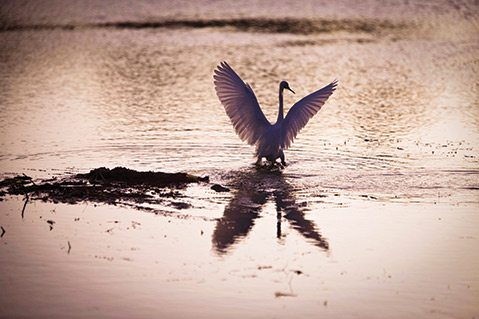Parasite Paradise
How the Opportunist Organisms Help Marshlands Thrive

Walking through UCSB’s Carpinteria Salt Marsh Natural Reserve, it’s easy to forget the surrounding homes, train tracks, and highway. In the previous century, the marsh was much larger, but development has chipped away at it. It’s a common story ― nearly 90 percent of coastal marshland has been destroyed or degraded. Gone are the plants and animals they supported, the ability to filter runoff water, to buffer the coastline against storm surge, and to provide natural storage of carbon and other minerals and nutrients. These services make coastal marshes important habitat to protect, and, consequently, restoration efforts throughout California have been initiated to reinvigorate marshes.
Although restoration intentions are noble, there is some question as to whether resurrected marshes function as they did before being disturbed. How can we measure success? One method biologists and ecologists use to test ecosystem functioning is the food web structure. If the plants and animals return, it has succeeded, right? Maybe not. The mere presence of organisms doesn’t mean they are thriving, reproducing, and going to maintain area populations over the long-term.
A better indicator may, ironically, be nestled within that coastal animal community: the parasites. Including parasites in the food web assessments provides a more reliable gauge as to whether the marsh is really an adequate habitat for plants and animals. Carpinteria is famous among biologists around the world not for being the “World’s Safest Beach” but because of its parasites; UCSB’s parasite ecology researchers have spent the last three decades working in this living laboratory. My postdoc study at the lab is to understand how parasites on birds and other marsh animals are distributed along the coast of California.
Carpinteria Salt Marsh Natural Reserve reveals birds aplenty. Willets wade along the shoreline, pulling small polychaete worms and tiny clams from their underwater burrows. Although the willet looks fine, it hosts a plethora of parasites, which it got when it ate prey infected with larval parasites or when it was fed on by fleas, mites, lice, or mosquitos.
Also lingering in the marsh is a great egret, a brilliant white bird that stalks small fishes in the deeper channels. Like the willet, the egret is infected with parasites and does not show outward signs of disease. In fact, the birds are able to catch and eat more prey because of the marsh parasites. For example, the small, schooling killifish show altered behaviors when infected with parasites, making them more visible to predators. Their flashing and shimmying make them easier to see and reduces the time it takes the birds to find a meal, while simultaneously ensuring that the parasites in the fish make it to their next host ― an ingenious technique.
For more information on what’s happening in the Ecological Parasitology Lab at UCSB, visit parasitology.msi.ucsb.edu.



